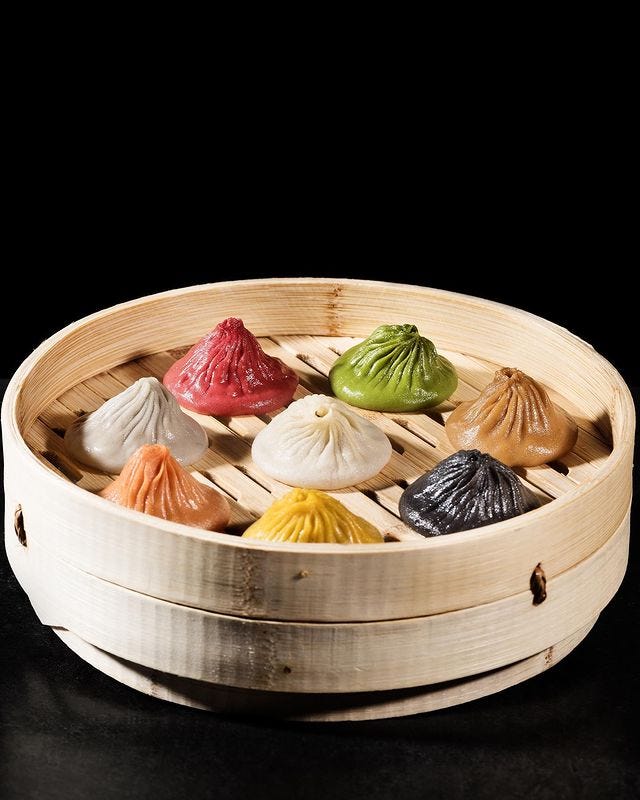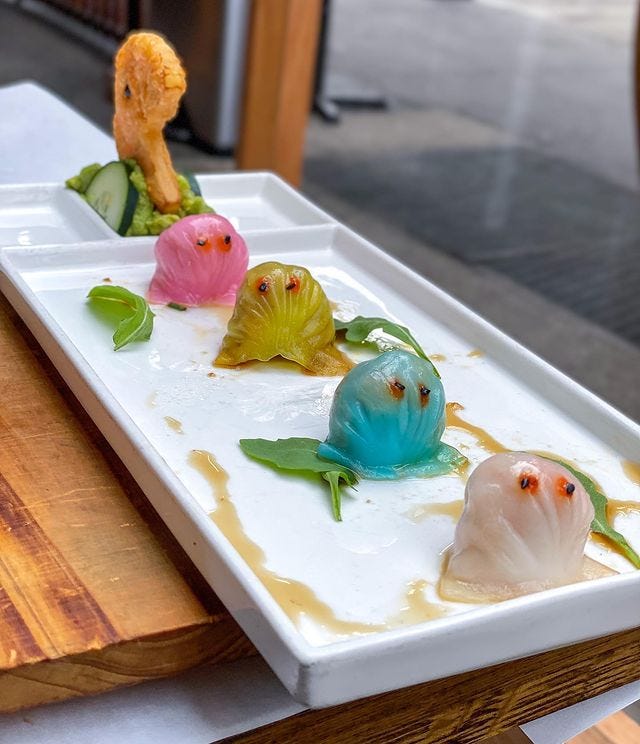Dumpling Digest: Tasting the Rainbow, Part 1
The first in a multi-part series that's all about multi-hued dumplings.

Welcome to Above the Fold, a free, bi-monthly newsletter all about dumplings and the people who make them. Like what you see? Subscribe and it’ll come straight to your inbox every other Wednesday.
Dumpling Digest is back, this time with a theme: Rainbow dumplings. In our modern, Instagram-obsessed era, beautifully composed, brightly colored things have plenty of visual appetite appeal—which is why I’ve been seeing more and more of them all over my feeds in recent years. (To be very clear, as far as “rainbow everything” food trends go: rainbow bagels = thumbs down; rainbow dumplings: thumbs up!)
What started as a few saved images and articles here and there over the years has since morphed into a full-fledged rabbit hole with too much material for a single newsletter, so…buckle up, because this will be a multi-part series!

To start, there are many reasons for changing the color of dumpling dough. There’s function, as a color-coded way to quickly discern which flavor you’re about to eat (like the multi-colored patties that Chantal Thomas makes for Amazing Ackee). There’s symbolism that’s traditional, like pink, green, and white hanami dango1, the sweet rice dumplings enjoyed during cherry blossom season in Japan (see above).
There’s symbolism that deliberately riffs with the traditional, like Nuit Regular’s multi-colored variations of the purple Royal Thai dumpling chor muang; renditions of gujiya, the sweet, Indian deep-fried dumpling commonly consumed during Holi, that infuse the festival’s bright color palette right into the dough (see above); and the rainbow pelmeni (below) that Dacha 46’s Trina Quinn painstakingly created for Pride month.
There’s straight-up artistic expression, as demonstrated by chef Sandy Ho and her beautifully swirled and tie-dyed rainbow dumplings for Sandita’s.
This series will take a look at the modern rainbow dumpling landscape, from the major restaurants that have parlayed multi-hued parcels into ultra-successful businesses, to the bloggers and small businesses working magic with everything from black carrot powder to beet puree. I’ll also share recommended recipes for making your own at home. First up: The restaurants that brought multi-colored dumplings to our minds and bellies.
Paradise Dynasty, Singapore
In 2010—same year as the launch of Instagram—Eldwin Chua opened the first location of Paradise Dynasty in Singapore2. The restaurant is anchored by a signature dish: “Specialty Dynasty” xiao long bao, a set of eight multi-hued soup dumplings with each individual dumpling color representing a different flavor profile (fillings range from cheese to foie gras to crab roe). Chua’s creation was inspired by colorful boxes of French macarons, and its popularity has led Paradise Dynasty to open nearly 50 locations globally, with the first U.S. location having just opened in Orange County—in the same plaza as the most famous international soup dumpling restaurant group, Din Tai Fung. (Bold move!)
According to this 2017 article in China Daily, Chua has sold a minimum of 500,000 rainbow XLBs every month since the dish debuted, a number that’s surely climbed as his business has grown.
While Paradise Dynasty claims to have created the world’s first rainbow soup dumplings, other savvy restaurants have since followed suit. There’s Vancouver’s Jingle Bao, which opened in 2019 and gives each delicate soup dumpling its own tiny swing seat for protection (below).
When famed New York soup dumpling restaurant Nan Xiang Xiao Long Bao reopened in 2019, they added a “lucky six” set of rainbow soup dumplings to the menu. During the pandemic, they made their stunning dumplings available in frozen form, and NYC residents can order five of each color for $30.
Red Farm, New York
Red Farm, a collaboration between dim sum master Joe Ng and restaurateur Ed Shoenfeld, opened in the West Village in 2011. The signature “Pac-Man” dumplings, a whimsical riff on Cantonese shrimp-filled har gow, starred in the lede of Pete Wells’s 2012 review for The New York Times. Here’s a snippet:
They have plaintive black sesame-seed eyes, the dumplings at RedFarm, giving them the appearance of strange, adorable characters in a Miyazaki film. Over here are Blinky, Pinky, Inky and Clyde, spectral shrimp dumplings in blue, pink, yellow and white, chasing a Pac-Man made of sweet potato tempura with a blueberry for an eye. [ed note: Pete’s dumplings must have been facing the opposite direction of those in the image below]
Since then, Red Farm has opened up several locations in New York as well as in London, and produces upwards of 20,000 dumplings by hand each week (not all of these are the Pac-Man style, but they surely account for a big proportion). Apparently, the dumplings even made an appearance in a recent episode of Billions.
Learn more about how they’re made in the video below (jump to 1:33).
Mister Jiu’s, San Francisco
In 2016, Brandon Jew opened Mister Jiu's in San Francisco's Chinatown, a super-personal restaurant combining his culinary training in California cuisine with his Chinese-American roots and family memories.
One of the signature dishes: Seasonally rotating pot stickers filled with plenty of local produce, with eye-catching wrappers dyed with fresh vegetable juice. Bon Appetit named Mister Jiu's one of America's Best New Restaurants in 2017, relevant in that it resulted in one of the most beautiful food images I've ever seen:
The recipe for these pot stickers can be found in Mister Jiu’s in Chinatown, a new(ish) cookbook from Jew and writer Tienlon Ho, with tips for coloring dough with baby spinach, beet juice, butternut squash, and red cabbage (as well as this lovely passage: “Making pot stickers is the fastest way to understanding what Chinese mean when they talk about the flavor of skillful hands.”). They don’t mess around with this recipe—it calls for grinding your own pork shoulder and back fat to achieve a singularly juicy filling—and I definitely plan to try it once I get my hands on the proper equipment. Even if complex recipes aren’t for you, this cookbook is absolutely worth the purchase for the deeply researched storytelling and stunning pictures.
Next week: A look at the bloggers using powders, purees, and juices as their at-home dumpling palettes.
Above the Fold was created by Leah Mennies. Logo + design elements by Claudia Mak.
Learn more about hanami dango in Namiko Chen’s incredibly comprehensive post for Just One Cookbook.
The Los Angeles Times has a great piece about Paradise Dynasty’s origins.















